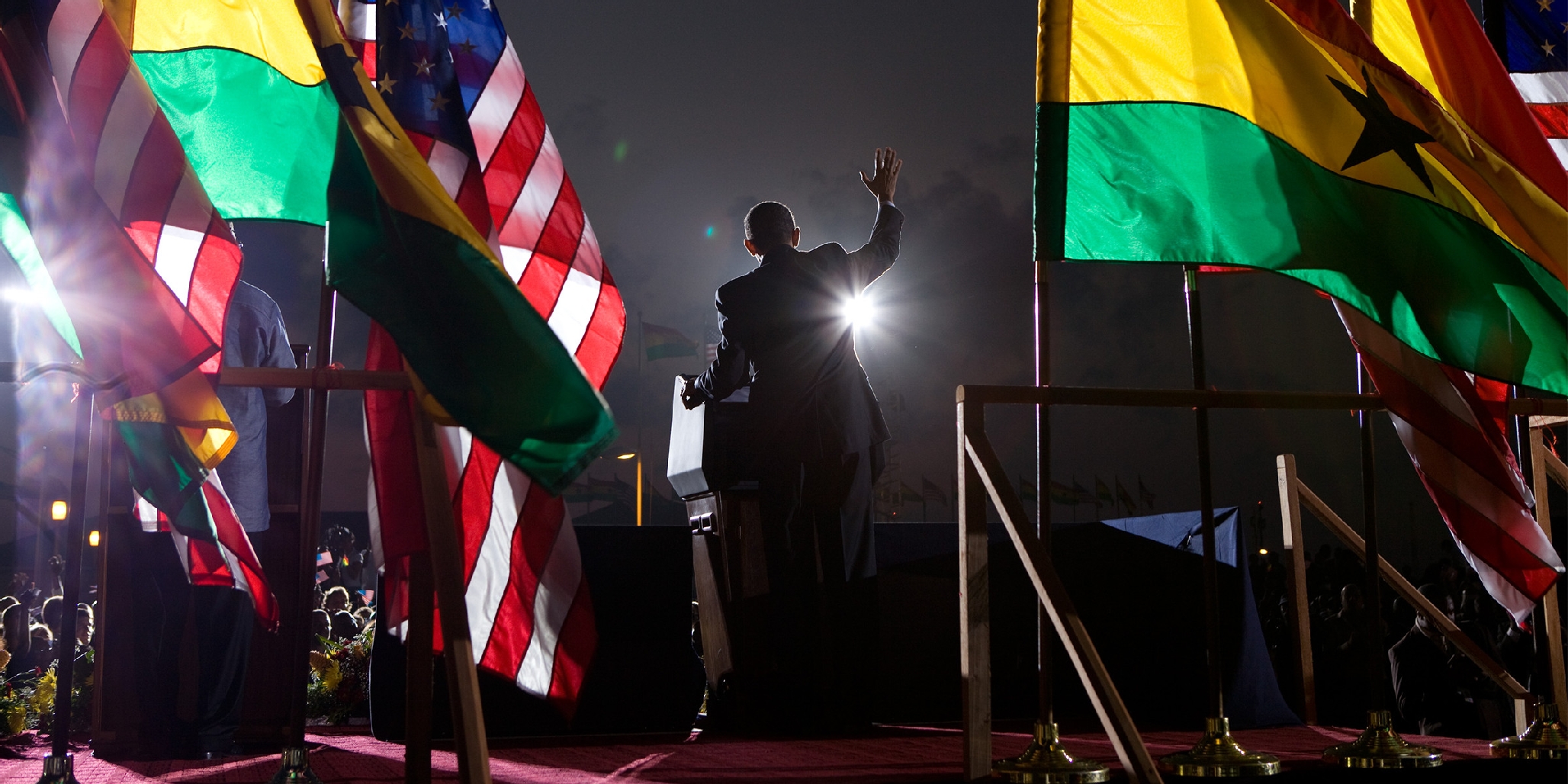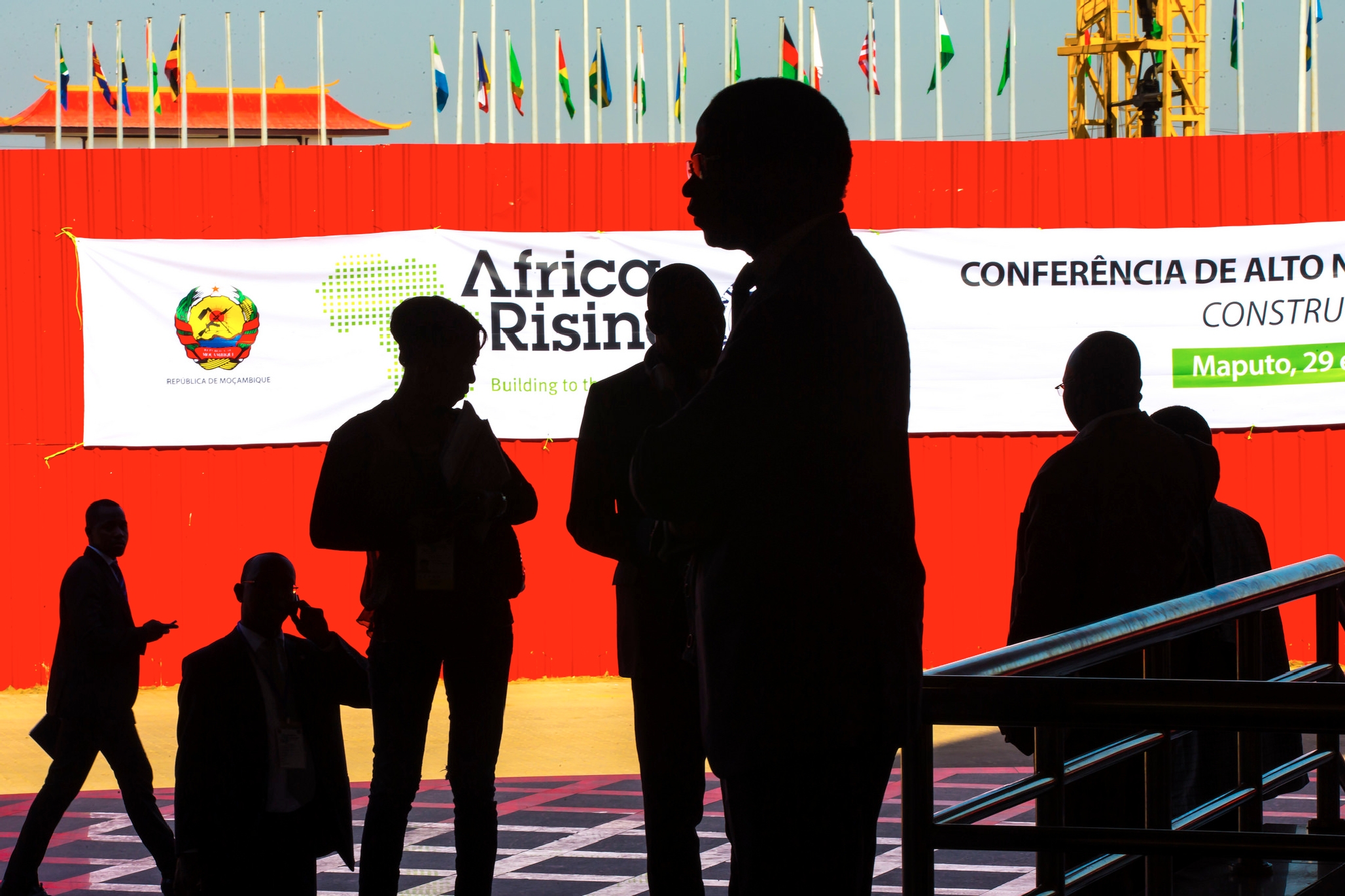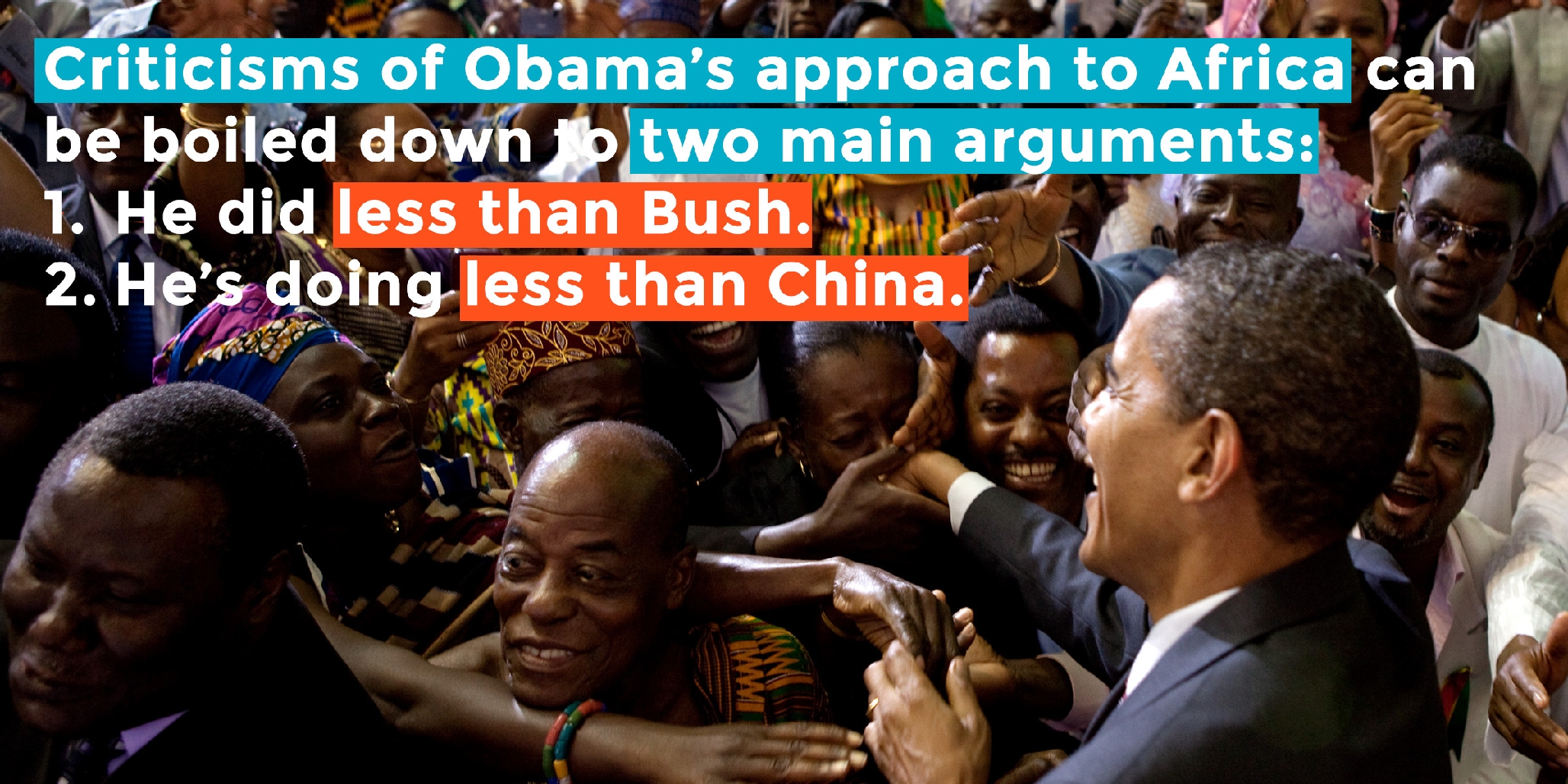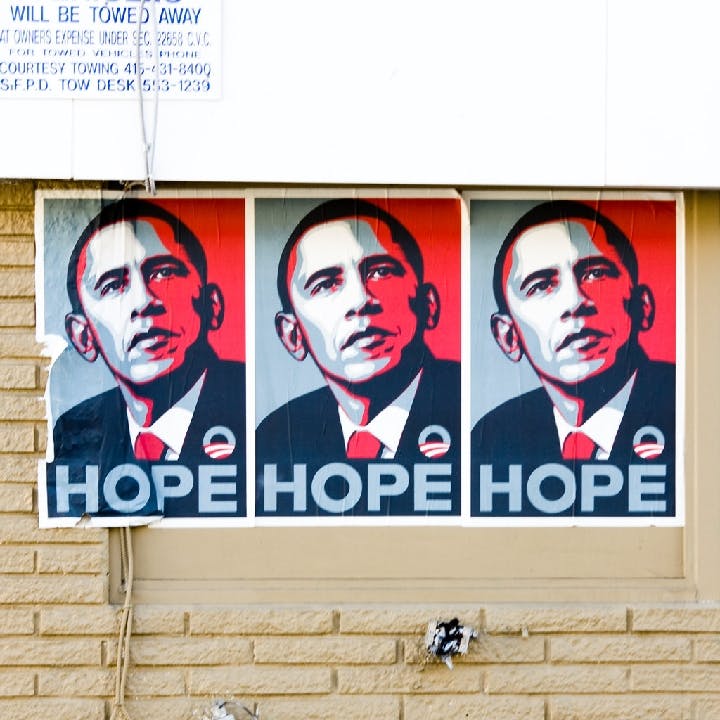Winter 2016
Transformational change? Time will tell.
– K.Y. Amoako
Critics of Obama’s efforts in Africa abound, but they may be rushing to judgment — and missing the bigger picture.
During the summer of 2009, Barack Obama visited Accra, Ghana, during his first trip to sub-Saharan Africa as president of the United States. At the time, I served alongside a small group of veteran Ghanaian policy experts offering advice to John Atta Mills, then Ghana’s president. During one of our meetings, talk turned to Obama and whether he intended to use the historic nature of his visit — the first American president of African descent coming to Africa — to announce new policy initiatives or aid packages that would dwarf the substantial efforts of his predecessor, George W. Bush. One after another, my fellow advisory council members predicted big things, major things.
But I had bad news for them.
A few weeks prior, I had the opportunity to discuss Obama’s upcoming trip with a delegation of American political, business, and philanthropic leaders who were convened by the ONE campaign, an organization I had advised on matters of policy. The group’s members — several of whom had served in Bill Clinton’s administration or had contacts in the Obama White House — came to Ghana to explore developmental issues and learn about what was working, what was not, and what more was needed to empower poor people. What they said surprised me: Obama planned to focus his “African message” primarily on the continent’s ongoing need for better political and economic leadership at home. He would not make any grand pronouncements. He would not propose any bold policy.
When I passed this information along to the others on the council, no one believed me — or, at least, none of them wanted to believe. Surely Obama, the son of a Kenyan, would have to do more than Bush, right?
One of my fellow council members, apparently blinded by the same “Obamamania” gripping Accra and the rest of Africa, rejected the news outright. He predicted that Obama would, at long last, be the world leader to propose a global aid and development package for Africa that would rival the post-World War II Marshall Plan for Europe. He was certain of it.
Surely Obama, the son of a Kenyan, would do more in Africa than Bush, right?

Of course, Obama did not announce a Marshall Plan for Africa. Instead, when he visited Ghana, he delivered what could best be described as a “tough love” speech, acknowledging Africa’s notable gains and economic growth but reiterating Africa’s need to accept responsibility for the failures of its past and direction of its future. They were powerful words, but also a little haughty — not what many Africans expected (or wanted) to hear.
And yet, scattered throughout were obvious signals for how he and his administration would attempt to engage Africa. Obama downplayed foreign aid and talked up foreign investment. He touted public-private partnerships, equitable access to finance, and skilled labor as avenues out of poverty. He did emphasize the need for good governance, but he didn’t overplay the traditional neoliberal interpretation, which equates “good governance” primarily with democratic elections and free market policies, the rest be damned. Rather, he noted that strong and transparent institutions, together with a vibrant private sector and civil society, are what give life to democracy and strength to economic development.
“The true sign of success,” he said, in measuring the evolving Africa-U.S. partnership, “is not whether we are a source of perpetual aid that helps people scrape by; it's whether we are partners in building the capacity for transformational change.”
That line is a vital reference point when considering Obama’s approach to Africa, which has not yet been the boon that many predicted or anticipated — but the key word is yet. I think it’s too early to measure the absolute success or failure of Obama’s engagements, because, no matter one’s interpretation of their current impact, there is a connective tissue that runs through Obama’s varied initiatives that justifies taking a long-term view.
It’s evident that Obama preferred to focus more on Africa’s ability to sustain its growth rather than on quick-strike programs that may prove more popular in the moment but less transformative over time. While this approach stands in contrast to the one taken by George W. Bush, Africa’s place in the world — and its developmental needs — have evolved dramatically since the beginning of the Bush years. Obama’s approach can be seen as a product of this evolution. And in that way, the dominant narrative surrounding Obama and Africa is, at best, incomplete and, at worst, off the mark.
The dominant narrative surrounding Obama and Africa is, at best, incomplete and, at worst, off the mark.

Economic transformation is now the consensus framework for Africa’s development, a key component of long-term strategies endorsed in recent years by the African Union, African Development Bank, and the Economic Commission for Africa. In early 2015, African heads of state and government gathered to identify economic transformation as the first of six pillars to support Africa’s post-2015 development agenda and the UN’s Sustainable Development Goals. Many think tanks and other non-state actors have embraced the economic transformation agenda, as well.
What does that mean, exactly? At the African Center for Economic Transformation, we define it as economic growth with DEPTH — an acronym for the fundamental components of African economies that need more attention or policy reforms to ensure that developmental gains are lasting, instead of falling prey to the old cycle of booms and busts. Those components are diversified production; export competitiveness; productivity increases; technology upgrades; and human well-being, including higher incomes, well-rounded skills, and private-sector employment, particularly among Africa’s surging youth population.
Since 2000, the size of Africa’s economy has more than doubled. Still, the structure of most sub-Saharan economies has not changed much over the past 40 years.
The fact that we are even in the position to talk about more advanced development processes for Africa is proof of the continent’s remarkable economic turnaround since its nadir in the 1980s, when per-capita growth bottomed out. By the mid 1990s, we saw a number of factors emerge that helped jumpstart the turnaround, beginning with a commitment to better policy structures but also including more democratically elected leaders, improved governance, stronger economic management, debt relief, and a restructuring of the traditional donor-recipient dynamic. Increasingly, stable African states were determined to be treated as development partners, not just aid beneficiaries.
The results have been dramatic. Since 2000, the beginning of a decade in which six of the world’s 10 fastest-growing countries were in sub-Saharan Africa, the size of the African economy has more than doubled. The growth has given many African countries an emergent middle class and propelled investor interest — the flow of private capital now exceeds foreign aid. A 2013 survey by Ernst and Young found that 86 percent of global business leaders with an established presence on the continent believe that Africa’s appeal will only get stronger in the years ahead.
All this good news has, inevitably, given way to optimism that after years of war and famine and crippling debt, Africa is finally rising. It’s a good story that’s gotten great traction, but beneath the surface, things are not so simple.
Good economic news has spread optimism that Africa is finally rising. But beneath the surface, things are not so simple.
The Africa we talk about today — despite the gains and growth rates — continues to lag behind the rest of the world in poverty and most other economic indicators. The primary reason for that is as obvious as it is alarming: the structure of most sub-Saharan economies has not changed much over the past 40 years. Most African economies are still narrowly based on the production and export of unprocessed agricultural products, minerals, and crude oil. There is little manufacturing — indeed, in many countries the share of manufacturing in GDP is lower now than in the 1970s. As a result, productivity remains low, wages remain stagnant, unemployment remains endemic, and sustainability remains elusive.
So even if Africa is rising, it’s not transforming. It’s not growing with depth. But we know what that requires, and this is where Obama’s approach to Africa — if we separate it from the outsized expectations that greeted his election and from unfair comparisons to his predecessor — could prove transformative.
Even if Africa is rising, it’s not transforming; it’s not growing with depth.

When Obama made his fourth — and probably final — visit to Africa as president in July 2015, a historic trip that also took him to the African Union and Kenya, analysts in the global news media used the occasion to pick apart his administration’s perceived shortcomings on African engagement. The Economist said Obama had “neglected” Africa and “should do more to boost a growing continent” rather than “passively [continuing] with the actions of his bolder predecessors.” Politico, one of Washington, D.C.’s most respected political publications, offered a myriad of reasons for “how Obama disappointed Africa.” Foreign Policy magazine argued that the United States had become “detached” and “irrelevant” to Africa under Obama.
It’s a narrative with legs, and one that’s trailed Obama since his trip to Accra, which didn’t even last 20 hours.
After that visit ended, Obama did not return to Africa for the remainder of his first term, even while his secretary of state, Hillary Clinton, visited more than a dozen African nations during four separate trips. Along the way, the White House announced high-profile African initiatives on health care, climate change, and sustainable agriculture, but none gained much traction on the ground or in public opinion. Before Obama returned to Africa for his second trip in June 2013 (a largely symbolic visit to promote American trade and investment), a bipartisan trio of U.S. senators introduced an exports bill to prod the administration to improve U.S.-African trade and investment “The only thing missing,” said Illinois Senator Richard Durbin, “is a cohesive strategy on our end.”
The crux of the criticisms that developed during Obama’s first term and followed him through his second can be boiled down primarily to two arguments: he did less than Bush, and he’s doing less than China.

On the latter point, the evidence is hard to dispute. China is Africa’s largest trading partner and is pouring billions of dollars into the African economy through private-sector investments, grants, loans, and old-fashioned development assistance. Chinese influence over Africa is dwarfing that of the United States. In fact, when Obama became the first U.S. president to address the African Union, he did so in the AU’s glistening new Addis Ababa headquarters, a $200 million capital project funded by the Chinese as a “testimony” to the continuance of their relationship with Africa. There’s little doubt that during the Obama administration, the United States fell far behind China as a development partner, business partner, and country of influence.
As for the other main knock against Obama — that his commitment to Africa pales in comparison to that of George W. Bush — context is key.
Bush’s engagement with Africa came after a very high-profile “roadshow” — in 2002, TIME magazine called it Africa’s biggest “since Stanley met Livingstone” — conducted by the unlikely pair of U.S. Treasury Secretary Paul O’Neill and global rock star and activist Bono. I was fortunate to meet with the pair and a group of development leaders in Addis Ababa, where the conversation revolved around issues of corruption and transparency, Africa’s institutional capacity, and the commitment that African leaders have to improving living standards across the continent. The roadshow was credited with softening O’Neill’s outlook on the continent, and made a huge difference in persuading the Bush administration to open America’s wallet.
No American president had ever provided Africa with as much in terms of sheer financial resources as did George W. Bush
No American president had ever provided Africa with as much in terms of sheer financial resources as did George W. Bush. Likely, none ever will. Under Bush, U.S. aid for development to sub-Saharan Africa increased by more than 640 percent. At the same time, Bush helped secure an international agreement to provide 100 percent debt relief to the world’s poorest countries, most of which are in Africa. The Bush White House launched a series of landmark African achievements, including massive initiatives to combat HIV/AIDS and malaria. And Bush’s signature Millennium Challenge Corporation, a compact between the U.S. and developing countries that reach minimum governance thresholds, has been a boon for Africa, contributing approximately $6.5 billion for 25 development programs across 19 countries.
Why is this important? Because the Bush administration focused its resources primarily on emergency issues that had to be addressed for most African countries to have a reasonable shot at sustained growth. Insurmountable debt was strangling Africa’s potential. The scourge of HIV was crippling its workforce and creating millions of orphans. Poor governance was continually resulting in bad macroeconomic policy and management. These are not problems that have gone away, but Bush brought a renewed energy to them. They were immediate challenges that required the kind of aggressive response initiated by the United States. By the time Obama came into office in 2009, Africa already looked a lot different than when Bush first was elected in 2000. Africa had begun to grow, and while the same developmental problems existed, many more mechanisms and much greater financial resources had been put in place to combat them.
Obama, therefore, had the freedom to look at Africa’s economic growth, its “rising” narrative, and focus his initiatives less on emergency responses and more on long-term capacity development, renewable resources, and sustainable investments — none of which return immediate results. Meanwhile, the Bush administration’s President’s Emergency Plan for AIDS Relief, or PEPFAR, raised the number of sub-Saharan Africans getting antiretroviral drugs from an estimated 100,000 to 2 million in just five years. Obama’s Power Africa initiative, now in its third year, has yet to deliver electricity. Both are ambitious projects, but the former could be ramped up immediately, implemented through mass distribution of commodities like medicines and condoms, and measured accurately; the latter aims to add 60 million new electrical connections to a continent in which 57 percent of the population lives in the dark. Such an effort requires comprehensive structural change and reform at the country level, cutting across institutions and involving complex political economies, public-private partnerships, infrastructure development, and regulatory policy. It requires time and patience. If successful, it could also help transform Africa.
In just five years, Bush’s Emergency Plan for AIDS Relief raised the number of sub-Saharan Africans getting antiretroviral drugs from 100,000 to 2 million. Obama’s Power Africa initiative, now in its third year, has yet to deliver electricity.

Transformation doesn’t happen overnight. It’s a long-term process dependent on constructive relationships between the state and the private sector. The relationship is symbiotic. Private firms will lead in producing and distributing goods and services, in upgrading technologies and production processes, and in expanding employment. But those firms are reliant on a state with strong capabilities in setting an overall economic vision and strategy, efficiently providing supportive infrastructure and services, maintaining a regulatory environment conducive to entrepreneurial activity, and making it easier to acquire new technology and enter new markets.
All of this requires committed leadership. It requires political will and the institutional capacity to implement and coordinate the activities of all sectors in pursuing economic transformation. When Obama gave his “tough-love” speech in Ghana in 2009, and when he repeated many of those same themes in Kenya in 2015, he challenged Africans on issues of governance and corruption and public mismanagement because, first of all, he could — as an African descendent he had an opening to be more critical in a way that his predecessors could not — but also because performance on those issues are foundational underpinnings for all the other transformative elements he addressed — the same elements he subsequently sought to elevate and promote through administrative policies.
Transformation doesn’t happen overnight; it’s a long-term process.
Take Power Africa, Obama’s signature initiative to increase the continent’s electrical capacity and facilitate a transition to cleaner sources of power. Geographically, Power Africa is expansive, working across the breadth of the entire continent. As a point of comparison, PEPFAR was driven by U.S. funding allocated by Congress and made available for spending largely by Western nongovernmental organizations with a presence in Africa. Power Africa, by contrast, serves as a platform to bring together major outside donors (the African Development Bank, the World Bank, the EU and the governments of Sweden and the UK among them) and more than 100 private-sector investors into partnerships through which they design and finance power projects. For instance, in October 2015, Google announced that it would invest $40 million in the Lake Turkana Wind Power Project, which aims to deliver 310 megawatts of wind energy to Kenya’s electricity grid — an amount equivalent to 15 percent of the grid’s overall capacity. The Turkana wind power plant is the largest in Africa. Major infrastructure projects like this are complex and involve significant risk, but since they’re investment-driven and don’t rely solely on the annual congressional appropriations process for financing, they have the potential to be more sustainable over the long term.
Similarly, the Obama White House’s Doing Business in Africa (DBIA) campaign has aimed to make it easier for American and African businesses to partner, increasing trade and improving employment opportunities across both continents. Since launching in 2012, DBIA has facilitated investment and business deals between American, international, and African partners in sectors as diverse as aviation, construction, and energy. The Obama administration also pursued the renewal of the Africa Growth and Opportunity Act, which expands access to U.S. markets for businesses in qualifying African countries. In June 2015, Congress extended AGOA to be in effect through 2025.
Obama’s Africa agenda hasn’t focused solely on facilitating private investment and fostering U.S. business relations with Africa. He has also pursued a long-standing challenge that has stifled development over much of the continent: a dearth of quality leadership. Through the Young African Leaders Initiative, the Obama administration is trying to cultivate a network of more than 140,000 young African leaders, providing them with electronic access to online courses and tapping them into a platform through which they can build relationships with other leaders in business, government, and civil society. The vision is to inculcate the values, knowledge, and skills to effectively lead Africa’s institutions and to transform local communities through transparent and inclusive leadership.
Along those same lines, Obama’s highest-profile effort on Africa wasn’t a policy initiative at all, but an event: the first continent-wide U.S.-Africa Leaders Summit, which convened in Washington, D.C., in July 2014 with the aim of strengthening commercial ties, promoting new business opportunities, and exploring new partnerships. Obama hosted more than 50 African heads of state, generated some much-needed goodwill, brought some cohesion to his administration’s Africa strategy, and announced $33 billion in new and enhanced commitments, such as an additional $6 billion from the private sector for Power Africa. If the summit seemed reactive to the mounting criticisms of American disengagement, it also gave unprecedented prominence to the kind of public-private partnerships that drive economic transformation.

Even if we choose to see the glass as half full rather than half empty, we can’t be naive. Most of the Obama-era African initiatives remain more aspirational than demonstrable, but they generally contain core elements essential to Africa’s transformation process. Will they yield strongly positive results along the lines of Bush’s PEPFAR and Millennium Challenge Corporation? At this point, we can hope, but we cannot accurately judge. Power Africa, DBIA, YALI — these initiatives are built around long-term investments in Africa. They are not traditional aid and assistance programs. They are not blank checks. Could they come up short in the long run? Absolutely. But they are the kinds of development programs that open up current and future transformation pathways.
The overarching concern for most Obama-era initiatives in Africa is one of continuity. Power Africa launched with a five-year plan, but if its “sputtering start,” as the New York Times called it in July 2015, compromises even its baseline goals, how long until — pardon the pun — the plug is pulled? National transformation plans that extend across decades require continuing technical and financial support and the political will to stick with them. The same can be said for aspirational development initiatives.
Will Obama commit himself in his post-presidency to continuing to champion the “capacity for transformational change” that he described during his 2009 speech in Ghana?
But the onus to follow through is not only on Obama’s successor: it should be on Obama as well. Will he commit himself in his post-presidency to continuing to champion the “capacity for transformational change” that he described during his 2009 trip to Ghana? Or will the disappointment that followed his visit prove prophetic after all? I choose to take a wait-and-see approach, and to take Obama at his word.
“I don’t want to just sustain this momentum,” he said at the U.S.-Africa Leaders Summit in 2014. “I want to up it. I want to up our game.”
Time will tell.
* * *
Dr. K.Y. Amoako is founder and president of the African Center for Economic Transformation (ACET), and former executive secretary of the UN Economic Commission for Africa.
Cover image courtesy of Flickr/Thomas Hawk
